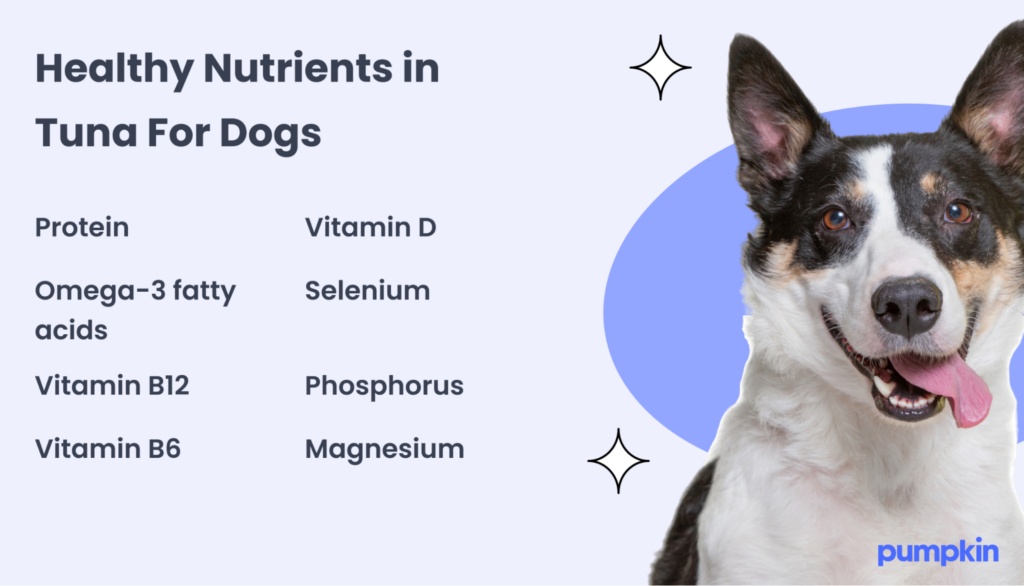Key Points
- Yes, dogs can eat tuna, but only in moderation and when prepared correctly.
- Tuna contains omega-3 fatty acids that are beneficial for a dog’s heart and skin health.
- Too much tuna can lead to mercury poisoning and other problems, so always monitor your dog’s tuna intake.
Tuna, the chicken of the sea. There are so many delicious things to do with it, from a classic tuna salad sandwich to a home-cooked tuna bake. And don’t even get us started on spicy tuna rolls. But should your dogs be getting in on the action?
Dogs can eat tuna, but moderation and preparation are both important. While tuna is full of healthy protein and omega-3 fatty acids, there’s a not-so-nice side to eating this popular seafood — mercury poisoning and nasty bacteria.
As scary as this sounds, this doesn’t mean that tuna is a no-go for dogs. Read on for the science-backed low-down on how much tuna is safe for your dog, its nutritional value, and the best ways to prepare this fish for your dog to enjoy.
Health benefits of tuna for dogs

The high nutritional value of tuna makes it a great source of protein, essential fatty acids, and vitamins.
A can (172g) of tuna in water contains approximately:
- 220 calories
- 5.11g of fat
- 40.6g of protein
- 0g of carbohydrate
- 648mg of sodium
- 72.2mg of cholesterol
Let’s break down what makes tuna delicious and nutritious for your dog:
High-quality protein
Tuna is packed with essential amino acids that help build and maintain your dog’s muscles and tissues. Protein also supports overall bodily functions and keeps the immune system strong. Other types of dog-safe seafood like salmon and shrimp are also healthy sources of protein.
Omega-3 fatty acids
The healthy fats found in tuna help promote a shiny coat and healthy skin while supporting heart and joint health. Omega-3s also have anti-inflammatory properties that can be beneficial for dogs, especially those with arthritis.
Vitamins and minerals
Tuna is rich in vitamins B12, B6, and D, which play a key role in your dog’s energy production, brain function, and bone health. Tuna also provides minerals like selenium, phosphorus, and magnesium, which are crucial for boosting your dog’s immune system and supporting bone growth.
Low in fat
Tuna is a lean source of protein when served without oils or seasonings, making it a good protein option for maintaining your dog’s weight.
Risks of feeding tuna to dogs
While a little bit of tuna can be healthy, there are risks to be aware of before letting your pup chow down.
Mercury poisoning
Tuna contains methylmercury, which can build up in a dog’s vital organs over time. This can lead to serious issues such as respiratory damage, kidney failure, and liver dysfunction.
Larger tuna species, like albacore, contain higher mercury levels than smaller varieties, making them especially risky for dogs. Generally, “light” tuna (often made from smaller fish like skipjack) tend to have lower mercury levels than “white” or albacore tuna.
Symptoms of mercury poisoning in dogs include:
- Lethargy
- Loss of coordination
- Loss of appetite
- Muscle tremors
- Vision impairment
If you notice these symptoms, seek veterinary advice right away.
Salt toxicity
Just 5 ounces of canned tuna contains more than 300 mg of sodium, which can cause dehydration or an electrolyte imbalance in dogs. In severe cases, too much salt can lead to conditions like sodium poisoning, affecting the heart and nervous system.
Allergic reaction
While tuna is generally safe for most dogs, some might develop a food allergy or sensitivity. Fish allergies in dogs are rare but not unheard of. Symptoms of a potential tuna allergy include:
- Excessive itching
- Red or inflamed skin
- Swelling, especially around the face and ears
- Digestive issues like vomiting or diarrhea
- Difficulty breathing
If you introduce tuna to your dog’s diet and notice any of these symptoms, consult your veterinarian. Your vet can do a dog allergy test and suggest other protein options for your dog.
Food poisoning
Sharing too much tuna, or tuna that’s not properly prepared, can upset your dog’s stomach, leading to vomiting, diarrhea, or general gastrointestinal distress. Tuna that’s raw or undercooked may also contain dangerous bacteria, causing food poisoning in people and pups alike.
Pancreatitis
Tuna with a higher fat content, especially if it’s canned in oil, can cause pancreatitis in dogs. This painful and potentially life-threatening inflammation of the pancreas requires immediate treatment.
Parasites
Raw tuna isn’t recommended for dogs due to the risk of parasites. Always stick to small amounts of cooked or canned tuna.
But what about your favorite sushi rolls? If it’s stored and handled properly, sushi-grade tuna should be safe for dogs, in theory. However, we’re reluctant to encourage pet owners to share raw meat of any kind with their dogs.

A Pumpkin pet insurance plan can help you and your pup be prepared for unexpected health concerns that arise in the future.
How to prepare tuna for dogs
Here’s how to keep tuna safe and digestible for your dog:
- Bone-free: Whether you’re offering canned tuna or fresh, ensure it’s free from any bones.
- Plain: Avoid feeding tuna with added sauces, spices, or seasonings. If using canned tuna, opt for those packed in water rather than oil or brine.
- Cooked: If you’re offering fresh tuna, make sure it’s thoroughly cooked. Raw fish can contain harmful parasites like tapeworms and roundworms.
- Moderation: Tuna should be an occasional treat, not a regular meal. Due to concerns about mercury levels in fish, it’s best to limit tuna intake.
You can also try mixing tuna with plain rice or vegetables like carrots and peas, for a wholesome, balanced meal or snack. Always limit treats to only 10% of their daily calories.
Alternatives to tuna for dogs
If you’re looking for alternatives to tuna, these fish and protein sources are both nutritious and delicious:
Always ensure that any fish or meat you offer is cooked and free of added salts, spices, or sauces.
Tuna: a tasty (occasional) treat for your dog
Tuna can be a tasty and healthy treat for your dog, thanks to its protein and omega-3s, which help with a shiny coat and heart health. But it’s important to only share tuna in small amounts. Too much tuna can lead to mercury build-up.
Keep your dog happy and healthy with the right diet, and you’ll see them thrive. A little moderation goes a long way, ensuring your furry friend gets the benefits without any risks. Lastly, always check with your vet to make sure tuna is a good fit for your pup’s diet.
FAQs
- https://fdc.nal.usda.gov/fdc-app.html#/food-details/175158/nutrients
- https://www.ncbi.nlm.nih.gov/pmc/articles/PMC5430166/
- https://www.simonvetsurgical.com/news/benefits-omega-3-fatty-acids-dogs-with-osteoarthritis
- https://www.purina.co.uk/articles/dogs/health/daily-care/vitamin-b-for-dogs
- https://www.ncbi.nlm.nih.gov/pmc/articles/PMC9291198/
- https://www.msdvetmanual.com/toxicology/mercury-poisoning/mercury-poisoning-in-animals
- https://www.everydayhealth.com/heart-health-pictures/10-sneaky-sodium-bombs.aspx
- https://animalemergencyservice.com.au/blog/understanding-salt-toxicity-in-dogs/
- https://www.seafoodhealthfacts.org/safety/parasites/
- https://www.akc.org/expert-advice/nutrition/how-many-treats-can-dog-have/




